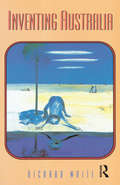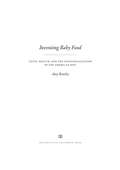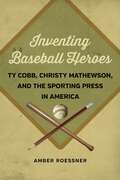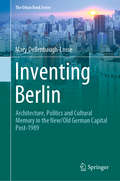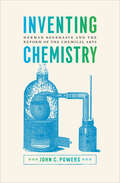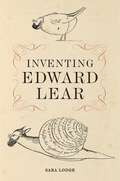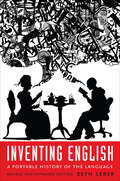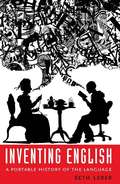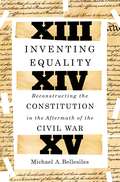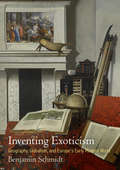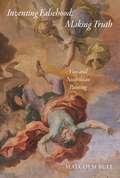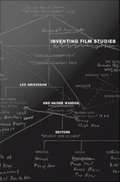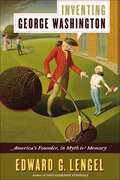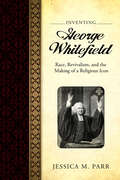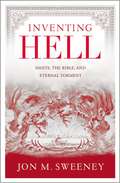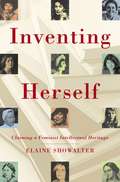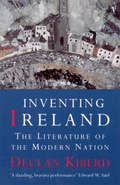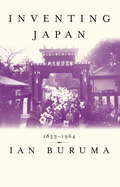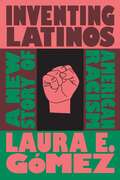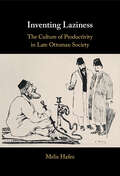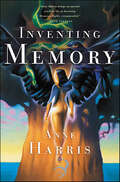- Table View
- List View
Inventing Atlantic Canada
by Corey SlumkoskiWhen Newfoundland entered the Canadian Confederation in 1949, it was hoped it would promote greater unity between the Maritime provinces, as Term 29 of the Newfoundland Act explicitly linked the region's economic and political fortunes. On the surface, the union seemed like an unprecedented opportunity to resurrect the regional spirit of the Maritime Rights movement of the 1920s, which advocated a cooperative approach to addressing regional underdevelopment. However, Newfoundland's arrival did little at first to bring about a comprehensive Atlantic Canadian regionalism.Inventing Atlantic Canada is the first book to analyse the reaction of the Maritime provinces to Newfoundland's entry into Confederation. Drawing on editorials, government documents, and political papers, Corey Slumkoski examines how each Maritime province used the addition of a new provincial cousin to fight underdevelopment. Slumkoski also details the rise of regional cooperation characterized by the Atlantic Revolution of the mid-1950s, when Maritime leaders began to realize that by acting in isolation their situations would only worsen.
Inventing Atmospheric Science: Bjerknes, Rossby, Wexler, and the Foundations of Modern Meteorology
by James Rodger FlemingHow scientists used transformative new technologies to understand the complexities of weather and the atmosphere, told through the intertwined careers of three key figures.“The goal of meteorology is to portray everything atmospheric, everywhere, always,” declared John Bellamy and Harry Wexler in 1960, soon after the successful launch of TIROS 1, the first weather satellite. Throughout the twentieth century, meteorological researchers have had global ambitions, incorporating technological advances into their scientific study as they worked to link theory with practice. Wireless telegraphy, radio, aviation, nuclear tracers, rockets, digital computers, and Earth-orbiting satellites opened up entirely new research horizons for meteorologists. In this book, James Fleming charts the emergence of the interdisciplinary field of atmospheric science through the lives and careers of three key figures: Vilhelm Bjerknes (1862–1951), Carl-Gustaf Rossby (1898–1957), and Harry Wexler (1911–1962).In the early twentieth century, Bjerknes worked to put meteorology on solid observational and theoretical foundations. His younger colleague, the innovative and influential Rossby, built the first graduate program in meteorology (at MIT), trained aviation cadets during World War II, and was a pioneer in numerical weather prediction and atmospheric chemistry. Wexler, one of Rossby's best students, became head of research at the U.S. Weather Bureau, where he developed new technologies from radar and rockets to computers and satellites, conducted research on the Antarctic ice sheet, and established carbon dioxide measurements at the Mauna Loa Observatory in Hawaii. He was also the first meteorologist to fly into a hurricane—an experience he chose never to repeat.Fleming maps both the ambitions of an evolving field and the constraints that checked them—war, bureaucracy, economic downturns, and, most important, the ultimate realization (prompted by the formulation of chaos theory in the 1960s by Edward Lorenz) that perfectly accurate measurements and forecasts would never be possible.
Inventing Australia: Images And Identity, 1688-1980 (Australian Experience Ser. #No. 3)
by Richard White'White sets himself a most ambitious task, and he goes remarkably far to achieving his goals. Very few books tell so much about Australia, with elegance and concision, as does his' - Professor Michael Roe'Stimulating and informative. an antidote to the cultural cringe' - Canberra Times'To be Australian': what can that mean? Inventing Australia sets out to find the answers by tracing the images we have used to describe our land and our people - the convict hell, the workingman's paradise, the Bush legend, the 'typical' Australian from the shearer to the Bondi lifesaver, the land of opportunity, the small rich industrial country, the multicultural society.The book argues that these images, rather than describing an especially Australian reality, grow out of assumptions about nature, race, class, democracy, sex and empire, and are 'invented' to serve the interests of particular groups.There have been many books about Australia's national identity; this is the first to place the discussion within an historical context to explain how Australians' views of themselves change and why these views change in the way they do.
Inventing Baby Food
by Amy BentleyFood consumption is a significant and complex social activity--and what a society chooses to feed its children reveals much about its tastes and ideas regarding health. In this groundbreaking historical work, Amy Bentley explores how the invention of commercial baby food shaped American notions of infancy and influenced the evolution of parental and pediatric care. Until the late nineteenth century, infants were almost exclusively fed breast milk. But over the course of a few short decades, Americans began feeding their babies formula and solid foods, frequently as early as a few weeks after birth. By the 1950s, commercial baby food had become emblematic of all things modern in postwar America. Little jars of baby food were thought to resolve a multitude of problems in the domestic sphere: they reduced parental anxieties about nutrition and health; they made caretakers feel empowered; and they offered women entering the workforce an irresistible convenience. But these baby food products laden with sugar, salt, and starch also became a gateway to the industrialized diet that blossomed during this period. Today, baby food continues to be shaped by medical, commercial, and parenting trends. Baby food producers now contend with health and nutrition problems as well as the rise of alternative food movements. All of this matters because, as the author suggests, it's during infancy that American palates become acclimated to tastes and textures, including those of highly processed, minimally nutritious, and calorie-dense industrial food products.
Inventing Baseball Heroes: Ty Cobb, Christy Mathewson, and the Sporting Press in America
by Amber RoessnerIn Inventing Baseball Heroes, Amber Roessner examines "herocrafting" in sports journalism through an incisive analysis of the work surrounding two of baseball's most enduring personalities -- Detroit Tigers outfielder Ty Cobb and New York Giants pitcher Christy Mathewson. While other scholars have demonstrated that the mythmakers of the Golden Age of Sports Writing (1920--1930) manufactured heroes out of baseball players for the mainstream media, Roessner probes further, with a penetrating look at how sportswriters compromised emerging professional standards of journalism as they crafted heroic tales that sought to teach American boys how to be successful players in the game of life.Cobb and Mathewson, respectively stereotyped as the game's sinner and saint, helped shape their public images in the mainstream press through their relationship with four of the most prominent sports journalists of the time: Grantland Rice, F. C. Lane, Ring Lardner, and John N. Wheeler. Roessner traces the interactions between the athletes and the reporters, delving into newsgathering strategies as well as rapport-building techniques, and ultimately revealing an inherent tension in objective sports reporting in the era. Inventing Baseball Heroes will be of interest to scholars of American history, sports history, cultural studies, and communication. Its interdisciplinary approach provides a broad understanding of the role sports journalists played in the production of American heroes.
Inventing Berlin: Architecture, Politics and Cultural Memory in the New/Old German Capital Post-1989 (The Urban Book Series)
by Mary Dellenbaugh-LosseThis book comprehensively examines post-1989 changes to the symbolic landscape of Berlin – specifically, street names, architecture, urban planning and monuments – and links these changes to concepts of contested cultural memory and national identity in Berlin and Germany in the post-Wall period. The core of the book is made up of an analysis of built space changes in the eastern half of the city before and after the Berlin Wall, flanked by an introduction to the theoretical underpinnings of the topic and a wider interpretation of the events in Berlin in relation to other geographic and historical contexts. It furthermore offers an explanatory model for the phenomenon of the "symbolic foreigner" whereby former citizens of the GDR feel disenfranchised and excluded from today's German society. This book is a valuable resource for researchers, students, and also appeals to a wider, non-academic audience with an interest in both cultural memory and Berlin.
Inventing Chemistry: Herman Boerhaave and the Reform of the Chemical Arts (Synthesis)
by John C. PowersThe story of this little-known Dutch physician &“will interest students and practitioners of history, chemistry, and philosophy of science&” (Choice). In Inventing Chemistry, historian John C. Powers turns his attention to Herman Boerhaave (1668–1738), a Dutch medical and chemical professor whose work reached a wide, educated audience and became the template for chemical knowledge in the eighteenth century. The primary focus of this study is Boerhaave&’s educational philosophy, and Powers traces its development from Boerhaave&’s early days as a student in Leiden through his publication of the Elementa chemiae in 1732. Powers reveals how Boerhaave restructured and reinterpreted various practices from diverse chemical traditions (including craft chemistry, Paracelsian medical chemistry, and alchemy), shaping them into a chemical course that conformed to the pedagogical and philosophical norms of Leiden University&’s medical faculty. In doing so, Boerhaave gave his chemistry a coherent organizational structure and philosophical foundation, and thus transformed an artisanal practice into an academic discipline. Inventing Chemistry is essential reading for historians of chemistry, medicine, and academic life.
Inventing Edward Lear
by Sara LodgeEdward Lear—the father of nonsense—wrote some of the best-loved poems in English. He was also admired as a naturalist, landscape painter, travel writer, and composer. Awkward but funny, absurdly sympathetic, Lear invented himself as a Victorian character. Sara Lodge offers a moving account of one of the era’s most influential creative figures.
Inventing English: A Portable History of the Language
by Seth LererSeth Lerer tells a masterful history of the English language from the age of Beowulf to the rap of Eminem. Many have written about the evolution of grammar, pronunciation, and vocabulary, but only Lerer situates these developments within the larger history of English, America, and literature. This edition features a new chapter on the influence of biblical translation and an epilogue on the relationship of English speech to writing. A unique blend of historical and personal narrative, Inventing English is the surprising tale of a language that is as dynamic as the people to whom it belongs.
Inventing English: A Portable History of the Language
by Seth LererWhy is there such a striking difference between English spelling and English pronunciation? How did our seemingly relatively simple grammar rules develop? What are the origins of regional dialect, literary language, and everyday speech, and what do they have to do with you? Seth Lerer's Inventing English is a masterful, engaging history of the English language from the age of Beowulf to the rap of Eminem. Many have written about the evolution of our grammar, pronunciation, and vocabulary, but only Lerer situates these developments in the larger history of English, America, and literature.Lerer begins in the seventh century with the poet Caedmon learning to sing what would become the earliest poem in English. He then looks at the medieval scribes and poets who gave shape to Middle English. He finds the traces of the Great Vowel Shift in the spelling choices of letter writers of the fifteenth century and explores the achievements of Samuel Johnson's Dictionary of 1755 and The Oxford English Dictionary of the late nineteenth and early twentieth centuries. He describes the differences between English and American usage and, through the example of Mark Twain, the link between regional dialect and race, class, and gender. Finally, he muses on the ways in which contact with foreign languages, popular culture, advertising, the Internet, and e-mail continue to shape English for future generations. Each concise chapter illuminates a moment of invention-a time when people discovered a new form of expression or changed the way they spoke or wrote. In conclusion, Lerer wonders whether globalization and technology have turned English into a world language and reflects on what has been preserved and what has been lost. A unique blend of historical and personal narrative, Inventing English is the surprising tale of a language that is as dynamic as the people to whom it belongs.
Inventing English: A Portable History of the Language
by Seth LererA history of English from the age of Beowulf to the rap of Eminem, &“written with real authority, enthusiasm and love for our unruly and exquisite language&” (The Washington Post). Many have written about the evolution of grammar, pronunciation, and vocabulary, but only Seth Lerer situates these developments within the larger history of English, America, and literature. This edition of his &“remarkable linguistic investigation&” (Booklist) features a new chapter on the influence of biblical translation and an epilogue on the relationship of English speech to writing. A unique blend of historical and personal narrative, both &“erudite and accessible&” (The Globe and Mail), Inventing English is the surprising tale of a language that is as dynamic as the people to whom it belongs. &“Lerer is not just a scholar; he's also a fan of English—his passion is evident on every page of this examination of how our language came to sound—and look—as it does and how words came to have their current meanings…the book percolates with creative energy and will please anyone intrigued by how our richly variegated language came to be.&”—Publishers Weekly (starred review)
Inventing Equality: Reconstructing the Constitution in the Aftermath of the Civil War
by Michael BellesilesThe evolution of the battle for true equality in America seen through the men, ideas, and politics behind the 13th, 14th, and 15th Amendments passed at the end of the Civil War. On July 4, 1852, Frederick Douglass stood in front of a crowd in Rochester, New York, and asked, “What to the slave is the Fourth of July?” The audience had invited him to speak on the day celebrating freedom, and had expected him to offer a hopeful message about America; instead, he’d offered back to them their own hypocrisy. How could the Constitution defend both freedom and slavery? How could it celebrate liberty with one hand while withdrawing it with another? Theirs was a country which promoted and even celebrated inequality. From the very beginning, American history can be seen as a battle to reconcile the large gap between America’s stated ideals and the reality of its republic. Its struggle is not one of steady progress toward greater freedom and equality, but rather for every step forward there is a step taken in a different direction. In Inventing Equality, Michael Bellesiles traces the evolution of the battle for true equality—the stories of those fighting forward, to expand the working definition of what it means to be an American citizen—from the Revolution through the late nineteenth century. He identifies the systemic flaws in the Constitution, and explores through the role of the Supreme Court and three Constitutional amendments—the 13th, 14th, and 15th—the ways in which equality and inequality waxed and waned over the decades.
Inventing Exoticism: Geography, Globalism, and Europe's Early Modern World (Material Texts)
by Benjamin SchmidtAs early modern Europe launched its multiple projects of global empire, it simultaneously embarked on an ambitious program of describing and picturing the world. The shapes and meanings of the extraordinary global images that emerged from this process form the subject of this highly original and richly textured study of cultural geography. Inventing Exoticism draws on a vast range of sources from history, literature, science, and art to describe the energetic and sustained international engagements that gave birth to our modern conceptions of exoticism and globalism.Illustrated with more than two hundred images of engravings, paintings, ceramics, and more, Inventing Exoticism shows, in vivid example and persuasive detail, how Europeans came to see and understand the world at an especially critical juncture of imperial imagination. At the turn to the eighteenth century, European markets were flooded by books and artifacts that described or otherwise evoked non-European realms: histories and ethnographies of overseas kingdoms, travel narratives and decorative maps, lavishly produced tomes illustrating foreign flora and fauna, and numerous decorative objects in the styles of distant cultures. Inventing Exoticism meticulously analyzes these, while further identifying the particular role of the Dutch—"Carryers of the World," as Defoe famously called them—in the business of exotica. The form of early modern exoticism that sold so well, as this book shows, originated not with expansion-minded imperialists of London and Paris, but in the canny ateliers of Holland. By scrutinizing these materials from the perspectives of both producers and consumers—and paying close attention to processes of cultural mediation—Inventing Exoticism interrogates traditional postcolonial theories of knowledge and power. It proposes a wholly revisionist understanding of geography in a pivotal age of expansion and offers a crucial historical perspective on our own global culture as it engages in a media-saturated world.
Inventing Falsehood, Making Truth: Vico and Neapolitan Painting (Essays in the Arts)
by Malcolm BullHow the philosophy of Giambattista Vico was influenced by eighteenth-century Neopolitan paintingCan painting transform philosophy? In Inventing Falsehood, Making Truth, Malcolm Bull looks at Neapolitan art around 1700 through the eyes of the philosopher Giambattista Vico. Surrounded by extravagant examples of late Baroque painting by artists like Luca Giordano and Francesco Solimena, Vico concluded that human truth was a product of the imagination. Truth was not something that could be observed: instead, it was something made in the way that paintings were made--through the exercise of fantasy.Juxtaposing paintings and texts, Bull presents the masterpieces of late Baroque painting in early eighteenth-century Naples from an entirely new perspective. Revealing the close connections between the arguments of the philosophers and the arguments of the painters, he shows how Vico drew on both in his influential philosophy of history, The New Science. Bull suggests that painting can serve not just as an illustration for philosophical arguments, but also as the model for them--that painting itself has sometimes been a form of epistemological experiment, and that, perhaps surprisingly, the Neapolitan Baroque may have been one of the routes through which modern consciousness was formed.
Inventing Film Studies
by Haidee Wasson Lee GrievesonInventing Film Studies offers original and provocative insights into the institutional and intellectual foundations of cinema studies. Many scholars have linked the origins of the discipline to late-1960s developments in the academy such as structuralist theory and student protest. Yet this collection reveals the broader material and institutional forces--both inside and outside of the university--that have long shaped the field. Beginning with the first investigations of cinema in the early twentieth century, this volume provides detailed examinations of the varied social, political, and intellectual milieus in which knowledge of cinema has been generated. The contributors explain how multiple instantiations of film study have had a tremendous influence on the methodologies, curricula, modes of publication, and professional organizations that now constitute the university-based discipline. Extending the historical insights into the present, contributors also consider the directions film study might take in changing technological and cultural environments. Inventing Film Studies shows how the study of cinema has developed in relation to a constellation of institutions, technologies, practices, individuals, films, books, government agencies, pedagogies, and theories. Contributors illuminate the connections between early cinema and the social sciences, between film programs and nation-building efforts, and between universities and U. S. avant-garde filmmakers. They analyze the evolution of film studies in relation to the Museum of Modern Art, the American Film Council movement of the 1940s and 1950s, the British Film Institute, influential journals, cinephilia, and technological innovations past and present. Taken together, the essays in this collection reveal the rich history and contemporary vitality of film studies. Contributors: Charles R. Acland, Mark Lynn Anderson, Mark Betz, Zo Druick, Lee Grieveson, Stephen Groening, Haden Guest, Amelie Hastie, Lynne Joyrich, Laura Mulvey, Dana Polan, D. N. Rodowick, Philip Rosen, Alison Trope, Haidee Wasson, Patricia White, Sharon Willis, Peter Wollen, Michael Zryd
Inventing George Washington: America's Founder, in Myth & Memory
by Edward G. LengelAn entertaining and erudite history that offers a fresh look at America's first founding father, the creation of his legend, and what it means for our nation and ourselvesGeorge Washington's death on December 14, 1799, dealt a dreadful blow to public morale. For three decades, Americans had depended on his leadership to guide them through every trial. At the cusp of a new century, the fledgling nation, caught in another war (this time with its former ally France), desperately needed to believe that Washington was—and would continue to be—there for them.Thus began the extraordinary immortalization of this towering historical figure. In Inventing George Washington, historian Edward G. Lengel shows how the late president and war hero continued to serve his nation on two distinct levels. The public Washington evolved into an eternal symbol as Father of His Country, while the private man remained at the periphery of the national vision—always just out of reach—for successive generations yearning to know him as never before.Both images, public and private, were vital to perceptions Americans had of their nation and themselves. Yet over time, as Lengel shows, the contrasting and simultaneous urges to deify Washington and to understand him as a man have produced tensions that have played out in every generation. As some exalted him, others sought to bring him down to earth, creating a series of competing mythologies that depicted Washington as every sort of human being imaginable. Inventing George Washington explores these representations, shedding new light on this national emblem, our nation itself, and who we are.
Inventing George Whitefield: Race, Revivalism, and the Making of a Religious Icon
by Jessica M. ParrEvangelicals and scholars of religious history have long recognized George Whitefield (1714-1770) as a founding father of American evangelicalism. But Jessica M. Parr argues he was much more than that. He was an enormously influential figure in Anglo-American religious culture, and his expansive missionary career can be understood in multiple ways. Whitefield began as an Anglican clergyman. Many in the Church of England perceived him as a radical. In the American South, Whitefield struggled to reconcile his disdain for the planter class with his belief that slavery was an economic necessity. Whitefield was drawn to an idealized Puritan past that was all but gone by the time of his first visit to New England in 1740.Parr draws from Whitefield's writing and sermons and from newspapers, pamphlets, and other sources to understand Whitefield's career and times. She offers new insights into revivalism, print culture, transatlantic cultural influences, and the relationship between religious thought and slavery. Whitefield became a religious icon shaped in the complexities of revivalism, the contest over religious toleration, and the conflicting role of Christianity for enslaved people. Proslavery Christians used Christianity as a form of social control for slaves, whereas evangelical Christianity's emphasis on "freedom in the eyes of God" suggested a path to political freedom. Parr reveals how Whitefield's death marked the start of a complex legacy that in many ways rendered him more powerful and influential after his death than during his long career.
Inventing Grand Strategy and Teaching Command: The Classic Works of Alfred Thayer Mahan Reconsidered
by Jon SumidaJon Sumida is a noted military historian of the 20th century with emphasis on naval developments. The first American works on this subject were those of Alfred T. Mahan and his Influence of Sea Power... books. Though considered out of date in the post WWI naval world, Dr. Sumida provides a new interpretation of these historical works.
Inventing Hell
by Jon M. SweeneyHell: The word means terror, darkness, and eternal separation from God. Some people think the Bible is clear about hell, but what if they're mistaken? With gripping narrative and solid scholarship, Sweeney charts hell's "evolution" from the Old Testament underworld Sheol, through history and literature, to the greatest influencer of all: Dante's Inferno. He reveals how the modern idea of hell is based mostly on Dante's imaginative genius-but in the process, he offers a more constructive understanding of the afterlife than ever before. Disturbing and enthralling, Sweeney will forever alter what we think happens to us after we die-and more importantly, he will make us reconsider how we live. Bible really says about heaven and hell, giving us a clearer, more hopeful understanding of the afterlife than ever before.
Inventing Herself: Claiming a Feminist Intellectual Heritage
by Elaine ShowalterSure to take its place alongside the literary landmarks of modern feminism, Elaine Showalter's brilliant, provocative work chronicles the roles of feminist intellectuals from the eighteenth century to the present. With sources as diverse as A Vindication of the Rights of Woman and Scream 2, Inventing Herself is an expansive and timely exploration of women who possess a boundless determination to alter the world by boldly experiencing love, achievement, and fame on a grand scale. These women tried to work, travel, think, love, and even die in ways that were ahead of their time. In doing so, they forged an epic history that each generation of adventurous women has rediscovered. Focusing on paradigmatic figures ranging from Mary Wollstonecraft and Margaret Fuller to Germaine Greer and Susan Sontag, preeminent scholar Elaine Showalter uncovers common themes and patterns of these women's lives across the centuries and discovers the feminist intellectual tradition they embodied. The author brilliantly illuminates the contributions of Eleanor Marx, Zora Neale Hurston, Simone de Beauvoir, Margaret Mead, and many more. Showalter, a highly regarded critic known for her provocative and strongly held opinions, has here established a compelling new Who's Who of women's thought. Certain to spark controversy, the omission of such feminist perennials as Susan B. Anthony, Eleanor Roosevelt, and Virginia Woolf will surprise and shock the conventional wisdom. This is not a history of perfect women, but rather of real women, whose mistakes and even tragedies are instructive and inspiring for women today who are still trying to invent themselves.
Inventing Ireland: The Literature of a Modern Nation
by Declan KiberdKiberd - one of Ireland's leading critics and a central figure in the FIELD DAY group with Brian Friel, Seamus Deane and the actor Stephen Rea - argues that the Irish Literary Revival of the 1890-1922 period embodied a spirit and a revolutionary, generous vision of Irishness that is still relevant to post-colonial Ireland. This is the perspective from which he views Irish culture. His history of Irish writing covers Yeats, Lady Gregory, Synge, O'Casey, Joyce, Beckett, Flann O'Brien, Elizabeth Bowen, Heaney, Friel and younger writers down to Roddy Doyle.
Inventing Japan
by Ian BurumaIn a single short book as elegant as it is wise, Ian Buruma makes sense of the most fateful span of Japan's history, the period that saw as dramatic a transformation as any country has ever known. In the course of little more than a hundred years from the day Commodore Matthew Perry arrived in his black ships, this insular, preindustrial realm mutated into an expansive military dictatorship that essentially supplanted the British, French, Dutch, and American empires in Asia before plunging to utter ruin, eventually emerging under American tutelage as a pseudo-Western-style democracy and economic dynamo.What explains the seismic changes that thrust this small island nation so violently onto the world stage? In part, Ian Buruma argues, the story is one of a newly united nation that felt it must play catch-up to the established Western powers, just as Germany and Italy did, a process that involved, in addition to outward colonial expansion, internal cultural consolidation and the manufacturing of a shared heritage. But Japan has always been both particularly open to the importation of good ideas and particularly prickly about keeping their influence quarantined, a bipolar disorder that would have dramatic consequences and that continues to this day. If one book is to be read in order to understand why the Japanese seem so impossibly strange to many Americans, Inventing Japan is surely it.From the Hardcover edition.
Inventing Latinos: A New Story Of American Racism
by Laura E. GómezWho are Latinos and where do they fit in America’s racial order? In this “timely and important examination of Latinx identity” (Ms.), Laura E. Gómez, a leading critical race scholar, argues that it is only recently that Mexican Americans, Puerto Ricans, Cubans, Dominicans, Central Americans, and others are seeing themselves (and being seen by others) under the banner of a cohesive racial identity. And the catalyst for this emergent identity, she argues, has been the ferocity of anti-Latino racism.
Inventing Laziness: The Culture of Productivity in Late Ottoman Society
by Melis HafezNeither laziness nor its condemnation are new inventions, however, perceiving laziness as a social condition that afflicts a 'nation' is. In the early modern era, Ottoman political treatises did not regard the people as the source of the state's problems. Yet in the nineteenth century, as the imperial ideology of Ottomanism and modern discourses of citizenship spread, so did the understanding of laziness as a social disease that the 'Ottoman nation' needed to eradicate. Asking what we can learn about Ottoman history over the long nineteenth-century by looking closely into the contested and shifting boundaries of the laziness - productivity binary, Melis Hafez explores how 'laziness' can be used to understand emerging civic culture and its exclusionary practices in the Ottoman Empire. A polyphonic involvement of moralists, intellectuals, polemicists, novelists, bureaucrats, and, to an extent, the public reveals the complexities and ambiguities of this multifaceted cultural transformation. Using a wide variety of sources, this book explores the sustained anxiety about productivity that generated numerous reforms as well as new understandings of morality, subjectivity, citizenship, and nationhood among the Ottomans.
Inventing Memory
by Anne HarrisA one-of-a-kind novel, like nothing you've ever read, Inventing Memory is a stunning blend of fantasy and reality, exposing the secret links between the mythic, the mundane, and the timeless mysteries of the human heart.Shula is a slave in fabled Sumer---until Inanna, Queen of Heaven, appears before her. Chosen by the Goddess for reasons she cannot begin to fathom, Shula is freed from bondage and set upon an uncertain path toward a new and mysterious destiny. But the attention of the gods is a dangerous thing, and Shula may have cause to regret the day she first laid eyes on the Holy Inanna.Wendy Chrenko, former high school misfit, is now an overworked graduate student, researching her dissertation "Remnants of Matriarchy in the Ancient Sumerian Inanna Cycle." Still smarting from the painful wounds of a failed love affair, Wendy is bound and determined to prove that men and women once lived together in perfect equality, even if it means volunteering for a bizarre and dangerous scientific experiment.Separated by millennia, Shula and Wendy appear to be two very different women, leading completely separate lives.Or maybe not.At the Publisher's request, this title is being sold without Digital Rights Management Software (DRM) applied.


